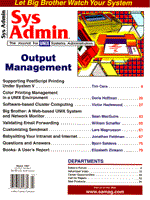
Editor's Forum
The March theme, output management, was once mostly concerned with getting the pinout on the printer's serial cable set up correctly. The strong orientation of UNIX toward ASCII text and all of its inherent portability benefits tended to make printing rather simple. Plain text equated to plain output. That is no longer the case. Today, UNIX printer systems must deal with complex page description languages, numerous page formats, and controlling color output, potentially with high-precision color matching. To complicate issues further, output management is no longer restricted to managing printers. Now, output management may involve configuring systems for faxing from the user's desktop, sending output to alpha-numeric pagers, and tailoring output for Web-based consumption. Gone are the simple days of figuring out how to include printer control strings into an lp filter so that 132-character wide code listings could be squeezed onto 8 1/2"-wide paper. Most of the public domain and shareware tools that fall into the output management category tend to be point solutions in the UNIX tradition - small tools for individual tasks, such as PostScript filtering. mpage, which prints a configurable number of pages of ASCII text on a single sheet of paper, is a good example of such a tool. We have also published several examples of pager control programs - small tools that access your system's modem to send a short alert string to your alpha-numeric pager as part of a system monitoring application or event management strategy. Commercially available output management tools range from complex systems that manage printing, faxing, and other forms of output across diverse heterogeneous computing environments to programs that control color printing. These commercial applications, for obvious reasons, tend to focus on areas of output management that are of concern to business. Providing color-calibrated output for test prints in a graphics shop or providing strategic control over printing in large corporations yield benefits that are easy to cost-justify in a business environment. Similarly, document management systems that allow large archives of corporate documentation to be printed or used as elements of a Web site have obvious management-level appeal. The challenge to the system administrator today is two-fold. First, we must recognize that output no longer just means printing. Pagers, fax systems, and the Web have been added to the traditional list of output devices. The second, potentially less straightforward, challenge is to recognize when a commercial application may be the most appropriate. Such situations suggest that we resist the natural do-it-yourself temptation and convince management that the business objective justifies the expense of the commercial application. A stretch of the traditional system administrator's comfort zone perhaps, but usually well worth the momentary anxiety.
Sincerely yours,
|